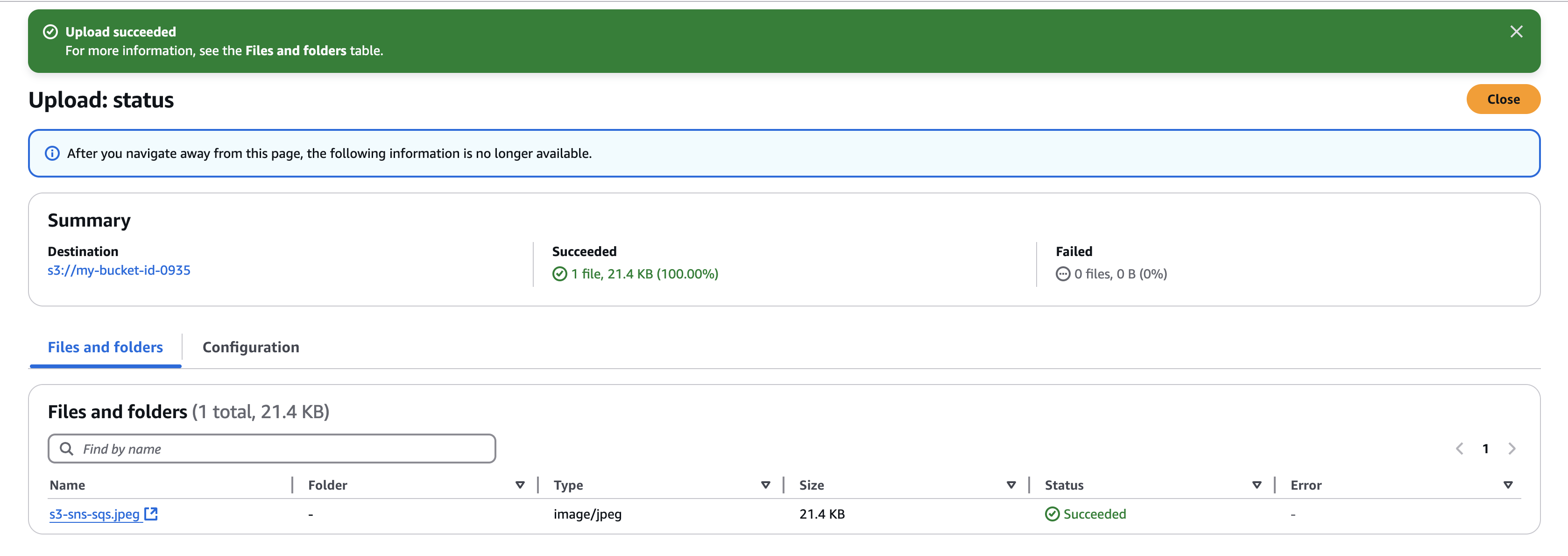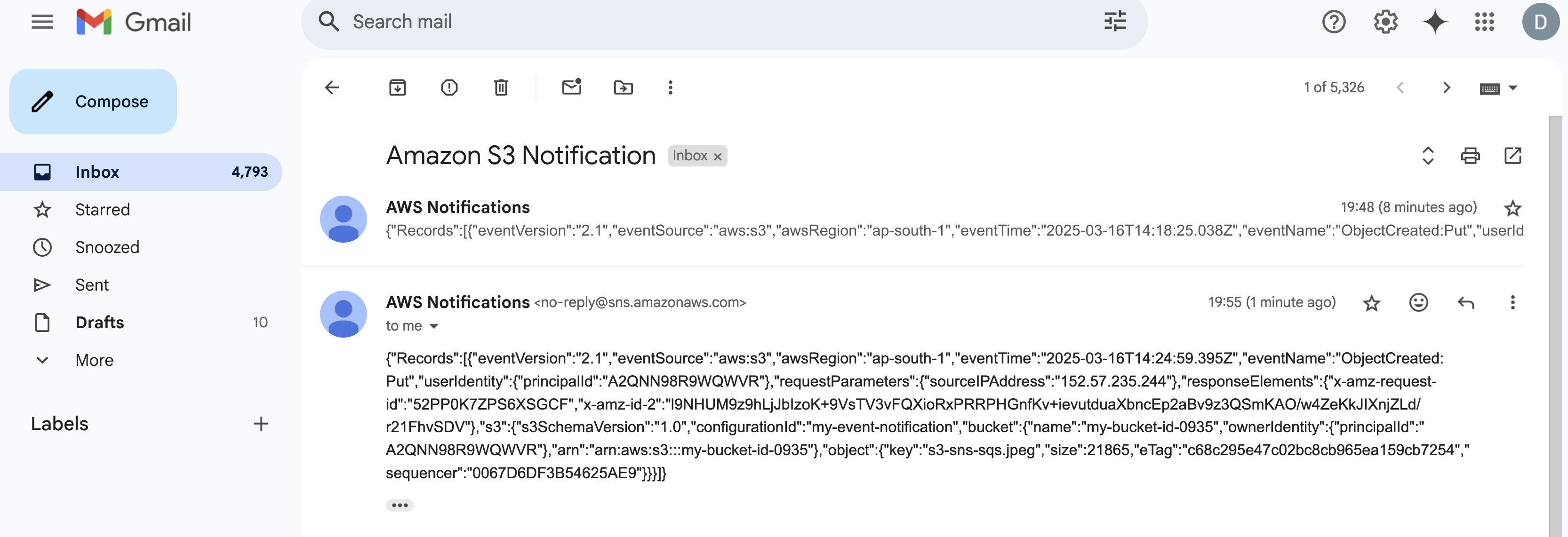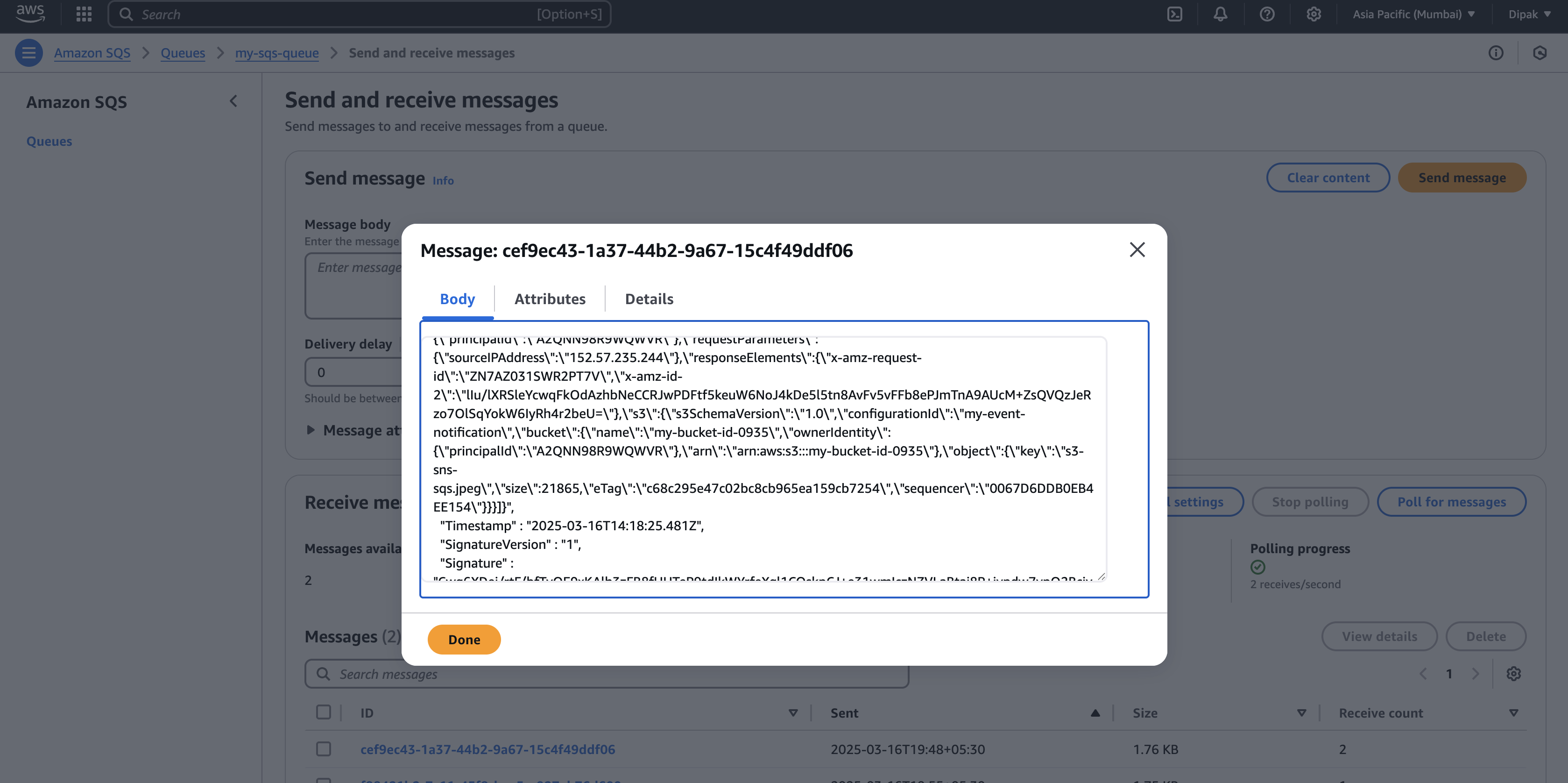How to Use SNS and SQS to Get S3 Event Notifications
 Dipak Mali
Dipak Mali
Introduction
Briefly introduce the importance of event-driven architecture in AWS.
Explain the common use case: Getting notifications when an S3 event (like file upload) occurs.
Highlight the role of SNS and SQS in handling event-based workflows.
Why Use SNS and SQS for S3 Event Notifications?
SNS (Simple Notification Service):
Real-time notification to multiple subscribers (e.g., Email, Lambda, SQS).
Fan-out capability – one event can notify multiple targets simultaneously.
SQS (Simple Queue Service):
Decouples systems and handles message persistence.
Ensures delivery and allows retries if the consumer fails.
Why Use Both Together:
SNS handles fan-out and notification.
SQS ensures message durability and allows async processing.
Step-by-Step Guide to Set Up SNS and SQS for S3 Event Notifications
Prerequisites:
AWS account
Basic understanding of AWS S3, SNS, and SQS
Step 1: Create an S3 Bucket
Navigate to the S3 console.
Create a new bucket (e.g.,
my-bucket-id-0935)
Step 2: Create an SNS Topic
Go to the SNS console.
Create a new topic (standard).
Name the topic (e.g.,
my-sns-topic)
Step 3: Create an SQS Queue
Go to the SQS console.
Create a new queue (standard).
Name the queue (e.g.,
my-sqs-queue).
Step 4: Policy Configurations
In SNS and SQS topics, Go to edit section.
In edit section update the access policies for both SNS and SQS topics.
SQS Policy:
{
"Version": "2012-10-17",
"Statement": [
{
"Effect": "Allow",
"Principal": {
"Service": "sns.amazonaws.com"
},
"Action": "sqs:SendMessage",
"Resource": "<SQS TOPIC ARN>",
"Condition": {
"ArnEquals": {
"aws:SourceArn": "<SNS TOPIC ARN>"
}
}
}
]
}
SNS Policy:
{
"Version": "2012-10-17",
"Statement": [
{
"Sid": "SNSPublish",
"Effect": "Allow",
"Principal": "*",
"Action": "SNS:Publish",
"Resource": "<SNS TOPIC ARN>"
}
]
}
Step 5: Subscribe SQS to the SNS Topic
Go to the SQS topic console.
Subscribe to Amazon SNS topic (
my-sns-topicarn)
Step 6: Subscribe an Email to the SNS Topic
In SNS, create a new subscription.
Choose
Emailas the protocol.Confirm the email subscription.
Step 7: Configure S3 to Send Events to SNS
Go to the S3 console.
Navigate to bucket settings → Event Notifications.
Create a new event notification:
Event type:
PUT(you can choose according to your need)Destination: SNS Topic (
my-sns-topic)
How It Works After Setup
File Upload Trigger: When a file is uploaded to S3, the event is triggered.
SNS Notification: S3 sends the event to the SNS topic.
Fan-Out: SNS sends the notification to both:
Email → Immediate alert to team.
SQS → Queues the message for further processing.
Process via SQS: The message sits in the SQS queue until a consumer (like Lambda) processes it.
Example
S3 file upload:

Email Notification:

SQS: Poll for message

Benefits of This Setup
✅ Real-time notifications with SNS.
✅ Durable message handling with SQS.
✅ Scalability – SNS and SQS handle high-volume traffic efficiently.
✅ Flexibility – Multiple services can subscribe to SNS simultaneously.
✅ Decoupling – SQS allows independent processing and failure handling.
Best Practices
Use Dead Letter Queues (DLQ) for failed SQS messages.
Add retry mechanisms to handle transient failures.
Use SNS message filtering to reduce unnecessary notifications.
Enable encryption on SNS and SQS for enhanced security.
Conclusion
Combining SNS and SQS for S3 event notifications creates a powerful, scalable, and reliable architecture. SNS handles real-time fan-out, while SQS ensures that no message is lost and allows decoupled processing. This setup is ideal for building event-driven applications and improving system resilience.
Subscribe to my newsletter
Read articles from Dipak Mali directly inside your inbox. Subscribe to the newsletter, and don't miss out.
Written by

Dipak Mali
Dipak Mali
Hello, I'm Dipak, a Junior Software Engineer with a strong foundation in React JS, Python, and Java. I’m a working professional focused on developing efficient software solutions in the dynamic adtech industry. Beyond core coding, I specialize in RESTful API design, web development, and have hands-on experience with technologies like Spring Boot, MySQL, Docker, and AWS cloud services. I thrive on creating scalable, user-centric applications and enjoy tackling complex problem-solving challenges. Eager to collaborate, I’m passionate about innovation, continuous learning, and making a meaningful impact through technology.